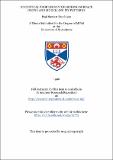Statistical problems in measuring surface ozone and modelling its patterns
Abstract
The thesis examines ground level air pollution data supplied by ITE Bush, Penicuik, Midlothian, Scotland. There is a brief examination of sulphur dioxide concentration data, but the Thesis is primarily concerned with ozone. The diurnal behaviour of ozone is the major topic, and a new methodology of classification of 'ozone days' is introduced and discussed. In chapter 2, the inverse Gaussian distribution is considered and rejected as a possible alternative to the standard approach of using the lognormal as a model for the frequency distribution of observed sulphur dioxide concentrations. In chapter 3, the behaviour of digital gas pollution analysers is investigated by making use of data obtained from two such machines operating side by side. A time series model of the differences between the readings obtained from the two machines is considered, and possible effects on modelling discussed. In chapter 4, the changes in the diurnal behaviour of ozone over a year are examined. A new approach involving a distortion of the time axis is shown to give diurnal ozone curves more homogeneous properties and have beneficial effects for modelling purposes. Chapter 5 extends the analysis of the diurnal behaviour of ozone begun in chapter 4 by considering individual 'ozone days' and attempting to classify them as one of several typical 'types' of day. The time distortion method introduced in chapter 4 is used, and a new classification methodology is introduced for considering data of this type. The statistical properties of this method are discussed in chapter 6.
Type
Thesis, MPhil Master of Philosophy
Collections
Items in the St Andrews Research Repository are protected by copyright, with all rights reserved, unless otherwise indicated.

